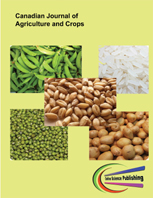Effect of the Time of N-Fertilizer Application on Growth and Yield of Wheat (TriticumAestivum L.) At Gamo-Gofa Zone, Southern Ethiopia
DOI:
https://doi.org/10.20448/803.1.2.60.69Keywords:
Wheat, Time of fertilizer application, Fertilizer, Nitrogen.Abstract
There is little knowledge among farmers on the time of N-fertilizer application at Gamo-gofa. Therefore, there is a need to determine time of N-fertilizer application on growth and yield of wheat. Accordingly, an experiment were conducted to evaluate the effect of the time of N-fertilizer application on yield and yield components of wheat on two locations at Gamo-gofa, Southern Ethiopia in 2014 and 2015 cropping season. The experiment consisted of single factor, which is the time of N-fertilizer application (at planting, 15, 30 days after planting and Control (no application)); was arranged in split plot design and replicated four times. Time of N-fertilizer application, year and location had significantly affected spike length and number of tillers. Also year and location had significantly affected maturity; whereas time of N fertilizer application and year of planting had significant effect on thousand seed weight. Time of N-fertilizer application, significantly affected days to heading, plant height and grain yield; whereas year was significantly affected harvest index, biomass and straw yield. Controls (no application) minimize the date of heading by ten days compared with fertilizer applied thirty days after planting. Wheat planted in 2014 was delayed the date of maturity by twenty days compared with planted in 2015. Planting of wheat at Bonkeworeda hasten the day for maturity by twenty days compared with planting at Chenchaworeda. Treatment which applied thirty days after planting had minimized plant height by 10.5 cm compared with control. Fertilizer applied thirty days after planting was contributed 2.8 cm increment in spike length than control, fertilizer applied at the time of planting and fifteen days after planting. Fertilizer applied thirty days after planting had 44.3 % more tillers than control. Wheat which planted in 2014 had maximized spike length by 44.4 % compared with planted in 2015. Wheat which planted in 2014 had increased biomass yield by 44.4 % compared with planted in 2015. Wheat which planted in 2014 had maximized straw yield by 44.4 % compared with planted in 2015. Fertilizer applied thirty days after planting had 16 % more thousand seed weight than control. Fertilized applied at thirty days after planting had 27.9 % more grain yield than no application. Harvest index is describes plant capacity to allocate biomass (assimilates) into the formed reproductive parts. Thus, it is possible to recommend that; N application thirty days after planting is effective in attaining higher grain yield and economic benefit of wheat in the trail area.


